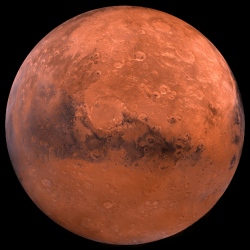
If all the solar energy arriving on Mars were to be captured, then Mars would warm to Earth-like temperatures in about 10 years. However, the efficiency of the greenhouse effect is plausibly about 10%, thus it would take about 100 years to warm Mars to Earth like temperatures.
This assumes, of course, adequate production of super greenhouse gases over that entire time. The super greenhouse gases desired for use on Mars would be per fluorinated compounds (PFCs) as these are not toxic, do not destroy ozone, will resist degradation by ultraviolet life, and are composed of elements (C, S, and F) that are present on Mars. Fluorine has been detected on Mars by Curiosity.
The Warming Phase of a terraforming project on Mars results in a planet with a thick CO2 atmosphere. The thickness is determined by the total releasable CO2 present on Mars.
The temperatures would become well above freezing and liquid water is common. An Earth-like hydrological cycle is maintained. Photosynthetic organisms can be introduced as conditions warm and organic biomass is thus produced. A rich flora and fauna are present. A natural result of this is the biological consumption of the nitrate and perchlorate in the
Martian soil producing N2 and O2 gas. While the pressure is high enough that humans do not need a space suit, they need a gas mask to provide O2 and prevent high levels of CO2 in the lungs.
The high O2 and low CO2 levels on Earth are due to photosynthesis which uses light to power the following transformation [H2O + CO2 = CH2O + O2 ] Where CH2O is a chemical representation of biomass. If all the sunlight incident on Mars was harnessed with 100% efficiency to perform this chemical transformation it would take only 17 years to produce high levels of O2.
On Earth the efficiency of the global biosphere in using sunlight to produced biomass and O2 is 0.01%.
Synthetic biology or molecular nanotechnology could boost the 0.01% efficiency. Advanced technology could boost the amount of sunlight focused on Mars or increase the available energy.
Without more advanced technology oxygenating the Mars atmosphere could take 100,000 years.
